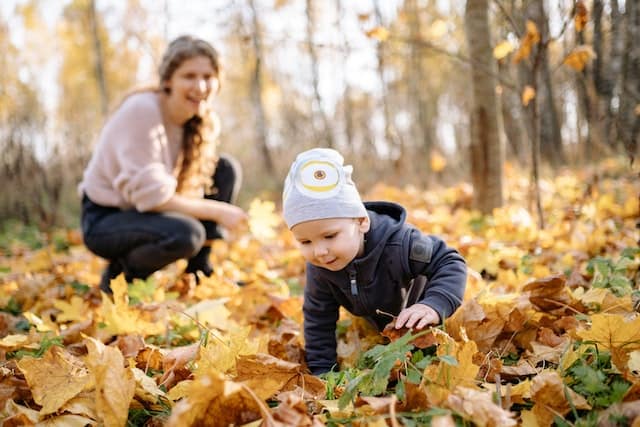Asymmetrical crawling is a common issue among infants and young children. It occurs when a child favors one side of their body while crawling, causing uneven weight distribution and potential developmental problems.
Asymmetrical crawling can lead to asymmetrical development of the body and brain, which may cause long-term issues if not addressed.
Understanding the causes of asymmetrical crawling is crucial in fixing the issue. Some common causes include muscle weakness, tightness, or imbalances, as well as neurological conditions like cerebral palsy. Identifying the root cause of the problem is the first step in finding a solution.
By addressing the underlying issue, parents and caregivers can help their child develop symmetrical crawling patterns and prevent long-term developmental problems.
Key Takeaways
- Asymmetrical crawling is a common issue among infants and young children that can lead to long-term developmental problems.
- Understanding the causes of asymmetrical crawling is crucial in finding a solution.
- Addressing the underlying issue is the first step in helping a child develop symmetrical crawling patterns and preventing long-term developmental problems.
See more on toddler development: Babies Walking On Knees
Understanding Asymmetrical Crawling
Asymmetrical crawling is a common issue that some babies experience during the crawling phase. It occurs when one side of the body is stronger or more dominant than the other side, causing the baby to move in a lopsided or uneven manner.
Identifying Asymmetrical Crawling
Parents can identify asymmetrical crawling by observing their baby’s movements during crawling. Asymmetrical crawling can be recognized by the following signs:
- The baby crawls with one arm and one leg while dragging the other arm and leg behind.
- The baby moves in a zigzag or circular pattern instead of moving straight ahead.
- The baby frequently changes the leading arm and leg while crawling.
Types of Asymmetrical Crawling
There are different types of asymmetrical crawling, including:
Bunny Hop Crawling
Bunny hop crawling is when the baby moves forward by hopping on both knees and both feet. This type of crawling is common in babies who have strong leg muscles but weaker arm muscles.
Bear Crawling
Bear crawling is when the baby crawls on all fours with the arms and legs extended straight. This type of crawling is common in babies who have stronger arm muscles than leg muscles.
Commando Crawl
Commando crawl is when the baby crawls on the stomach while pulling the body forward with the arms. This type of crawling is common in babies who have stronger arm muscles than leg muscles.
Bottom Scoot
Bottom scoot is when the baby moves forward by pushing with the feet while sitting on the bottom. This type of crawling is common in babies who have weaker arm and leg muscles.
Frog Leg Crawling
Frog leg crawling is when the baby crawls on all fours with the legs spread apart. This type of crawling is common in babies who have weaker leg muscles than arm muscles.
Club Crawling
Club crawling is when the baby crawls on all fours with the arms and legs bent. This type of crawling is common in babies who have weaker arm and leg muscles.
Bear Walking
Bear walking is when the baby walks on all fours with the arms and legs extended straight. This type of crawling is common in babies who have stronger arm muscles than leg muscles.
Crab Crawling
Crab crawling is when the baby crawls sideways on all fours with the arms and legs extended straight. This type of crawling is common in babies who have stronger arm muscles than leg muscles.
Understanding the type of asymmetrical crawling that your baby is experiencing can help you identify the cause and find ways to fix it.
Causes of Asymmetrical Crawling
Asymmetrical crawling is a common issue that parents face with their babies. It occurs when the baby crawls using one side of the body more than the other, resulting in an uneven movement pattern.
There are several factors that can cause asymmetrical crawling, including physical and neurological factors.
Physical Factors
Physical factors can play a significant role in causing asymmetrical crawling. These factors can include issues with muscle development, muscle imbalance, and poor body awareness.
Weak muscles, injury, and medical conditions such as hip dysplasia, scoliosis, and cerebral palsy can also contribute to asymmetrical crawling.
Muscle tone is another physical factor that can affect crawling. Low muscle tone can make it difficult for babies to maintain proper posture and balance, while high muscle tone can cause stiffness and limit movement.
Skeletal issues, such as misaligned joints or bones, can also impact crawling.
Neurological Factors
Neurological factors can also contribute to asymmetrical crawling. Babies with autism spectrum disorders (ASD) or other neurological conditions may have difficulty with body awareness and motor skills.
Vision issues can also affect crawling, as babies rely on visual cues to navigate their environment.
Midline development is an important neurological factor that can impact crawling. The midline is an imaginary line that divides the body into left and right halves. Babies who have difficulty crossing the midline may be more likely to crawl asymmetrically.
In conclusion, asymmetrical crawling can be caused by a variety of physical and neurological factors. It is important to identify the underlying cause of the issue to develop an appropriate treatment plan.
Parents should consult with a healthcare professional if they have concerns about their baby’s crawling pattern.
Effects on Physical and Cognitive Development
Mobility and Coordination
Asymmetrical crawling can lead to poor mobility and coordination skills in infants. Crawling helps in developing the strength and coordination of limbs, shoulders, and neck.
However, when a baby crawls asymmetrically, it may lead to muscle weakness and poor coordination skills. This can affect their ability to walk, run, and even play on the playground.
Additionally, asymmetrical crawling can also lead to developmental delays in infants. It can affect their ability to crawl over obstacles and play with balls. This can lead to poor playground skills and may even affect their ability to participate in physical activities later in life.
Cognitive Impact
Crawling plays a vital role in the cognitive development of infants. It helps in developing reciprocal movement, which is essential for the development of the brain.
However, when a baby crawls asymmetrically, it may lead to poor cognitive development.
Asymmetrical crawling can also affect sensory integration and vision development in infants. It may lead to poor muscle tone and affect their ability to sit on their side or belly.
This can also lead to hitch crawling, where the baby drags one leg behind the other.
Physical therapy, sensory integration therapy, and vision therapy can help infants with asymmetrical crawling. Crawling over obstacles, using crawling pants, crab walking, and different types of crawls can also facilitate proper crawling development.
In conclusion, asymmetrical crawling can have negative effects on both physical and cognitive development in infants. Parents should encourage tummy time, provide proper pillows and crawling mats, and seek professional help if they notice any developmental delays.
How to Fix Asymmetrical Crawling
Asymmetrical crawling is a common issue in infants and young children, which can lead to developmental delays and other complications.
Fortunately, there are several ways to address this issue and help your child develop a healthy crawling pattern.
Exercises and Techniques
One effective way to fix asymmetrical crawling is through exercises and techniques that encourage proper movement and muscle development.
Here are some techniques that can help:
- Sit up exercises: Encouraging your child to sit up straight can help improve their posture and strengthen their core muscles.
- Physioball exercises: Using a physioball can help your child develop their balance and coordination, which can improve their crawling pattern.
- Kneeling exercises: Kneeling exercises can help strengthen your child’s hip girdle and improve their overall posture.
- Abdominal exercises: Strengthening your child’s abdominal muscles can help improve their crawling pattern and overall movement.
Medical Interventions
In some cases, medical interventions may be necessary to fix asymmetrical crawling.
Here are some interventions that may be recommended by your pediatrician or healthcare provider:
- Vision therapy: If your child has vision issues, such as strabismus, it can affect their crawling pattern. Vision therapy can help improve their vision and overall movement.
- Surgery: In some cases, surgery may be necessary to correct underlying issues that are causing asymmetrical crawling.
- Sensory integration therapy: Sensory integration therapy can help improve your child’s overall sensory processing, which can improve their crawling pattern.
It’s important to work with your pediatrician or healthcare provider to determine the best course of action for your child. With the right techniques and interventions, you can help your child develop a healthy crawling pattern and avoid developmental delays.
Prevention of Asymmetrical Crawling
Asymmetrical crawling can be prevented by taking certain measures to ensure that the baby’s motor development is on track. Below are some ways to prevent asymmetrical crawling:
Tummy Time
Tummy time is an important way to help prevent asymmetrical crawling. When a baby spends time on their stomach, they develop the muscles in their neck, back, and shoulders, which are crucial for crawling.
Tummy time also helps to develop a baby’s core muscles, which are essential for balance and coordination.
Muscle Development
Muscle development is crucial for preventing asymmetrical crawling. Parents can help their babies develop their muscles by engaging them in various exercises such as leg lifts, bicycle kicks, and arm lifts.
These exercises help to develop the muscles in the hips, knees, and arms, which are all essential for crawling.
Body Awareness
Body awareness is another important factor in preventing asymmetrical crawling. Parents can help their babies develop body awareness by encouraging them to move in different ways.
For instance, parents can encourage their babies to roll from side to side, which helps to develop the muscles in their back and hips.
Vision
Vision is also important for preventing asymmetrical crawling. Parents can help their babies develop their vision by exposing them to different colors and patterns. This helps to stimulate their visual system, which is essential for crawling.
Physical Therapy
Physical therapy is another way to prevent asymmetrical crawling. Physical therapists can help babies develop their motor skills, balance, and coordination. They can also help babies develop their muscles, which is crucial for crawling.
By following these preventive measures, parents can help their babies develop the necessary skills and muscles to crawl symmetrically.
Frequently Asked Questions
How can I encourage my baby to crawl symmetrically?
There are several ways to encourage your baby to crawl symmetrically. One of the most effective ways is to create a safe and stimulating environment that encourages your baby to explore and move around.
You can also place toys and objects within reach of your baby to encourage them to crawl towards them. Additionally, you can place your baby on their hands and knees and gently rock them back and forth to encourage crawling movements.
What are the common causes of asymmetrical crawling in babies?
Asymmetrical crawling in babies can be caused by a variety of factors, including muscle weakness or tightness, hip dysplasia, torticollis, or other developmental delays.
It can also be caused by a preference for one side of the body due to an injury or discomfort.
What exercises can I do to help my baby with asymmetrical crawling?
There are several exercises that can help your baby with asymmetrical crawling. These include tummy time, which can help strengthen the muscles in your baby’s neck and shoulders, and crawling exercises that encourage your baby to use both sides of their body equally.
Additionally, stretching exercises can help improve your baby’s flexibility and range of motion.
Can asymmetrical crawling be a sign of a developmental delay?
Asymmetrical crawling can be a sign of a developmental delay, particularly if it persists beyond the age of six months.
If you notice that your baby is not crawling symmetrically or is having difficulty with other developmental milestones, it is important to speak with your pediatrician to rule out any underlying medical conditions.
Are there any assistive devices that can help my baby crawl symmetrically?
There are several assistive devices that can help your baby crawl symmetrically, including crawling aids and orthotics. These devices can help provide support and stability to your baby’s body, allowing them to move more easily and symmetrically.
What are the signs that my baby’s asymmetrical crawling may require medical attention?
If your baby is not crawling symmetrically or is having difficulty with other developmental milestones, it is important to speak with your pediatrician.
Additionally, if you notice that your baby is consistently using one side of their body more than the other, or if they are experiencing pain or discomfort while crawling, it may be a sign of an underlying medical condition that requires medical attention.
Related Posts:

Iesha is a loving mother of 2 beautiful children. She’s an active parent who enjoys indoor and outdoor adventures with her family. Her mission is to share practical and realistic parenting advice to help the parenting community becoming stronger.



